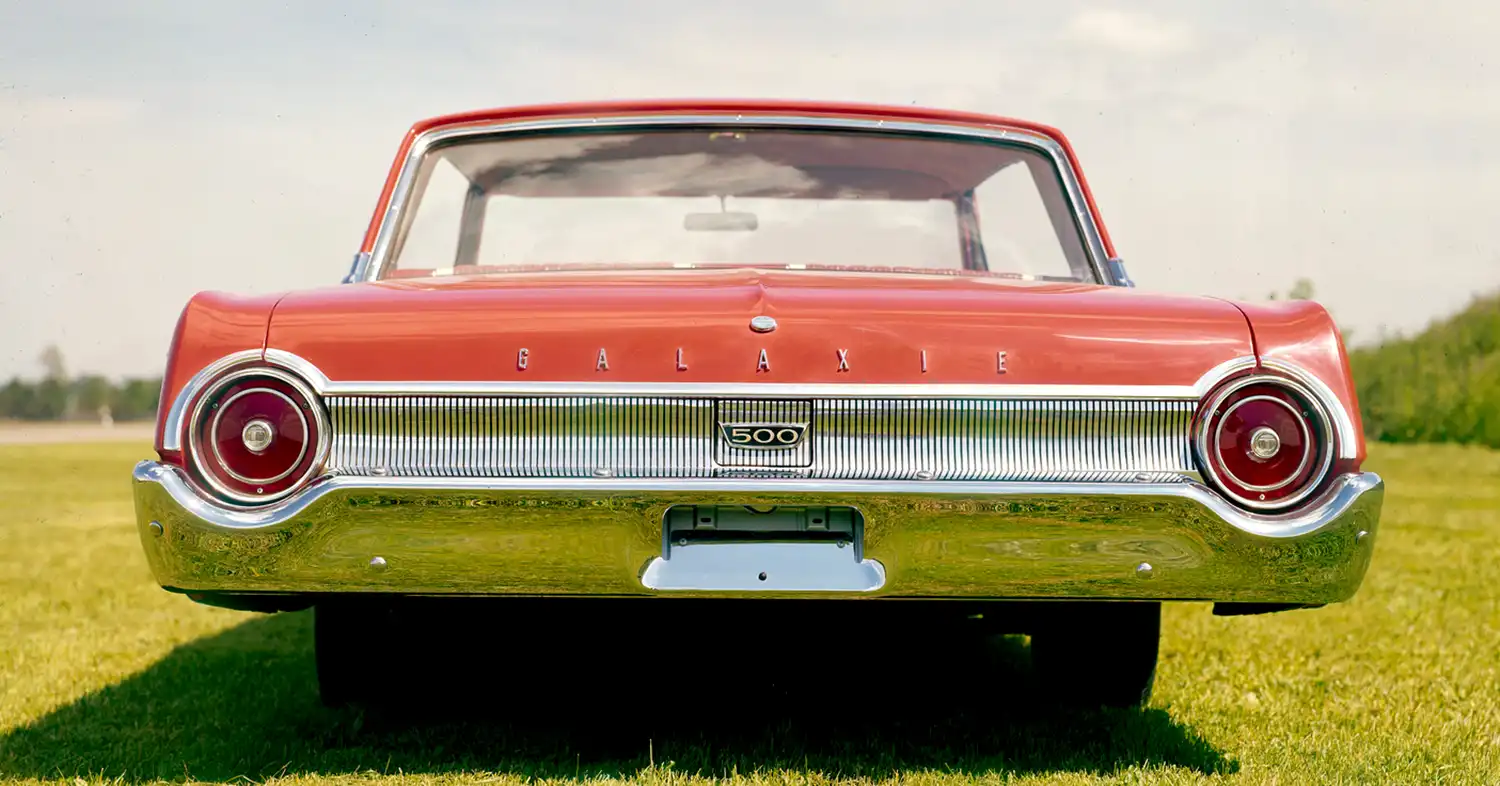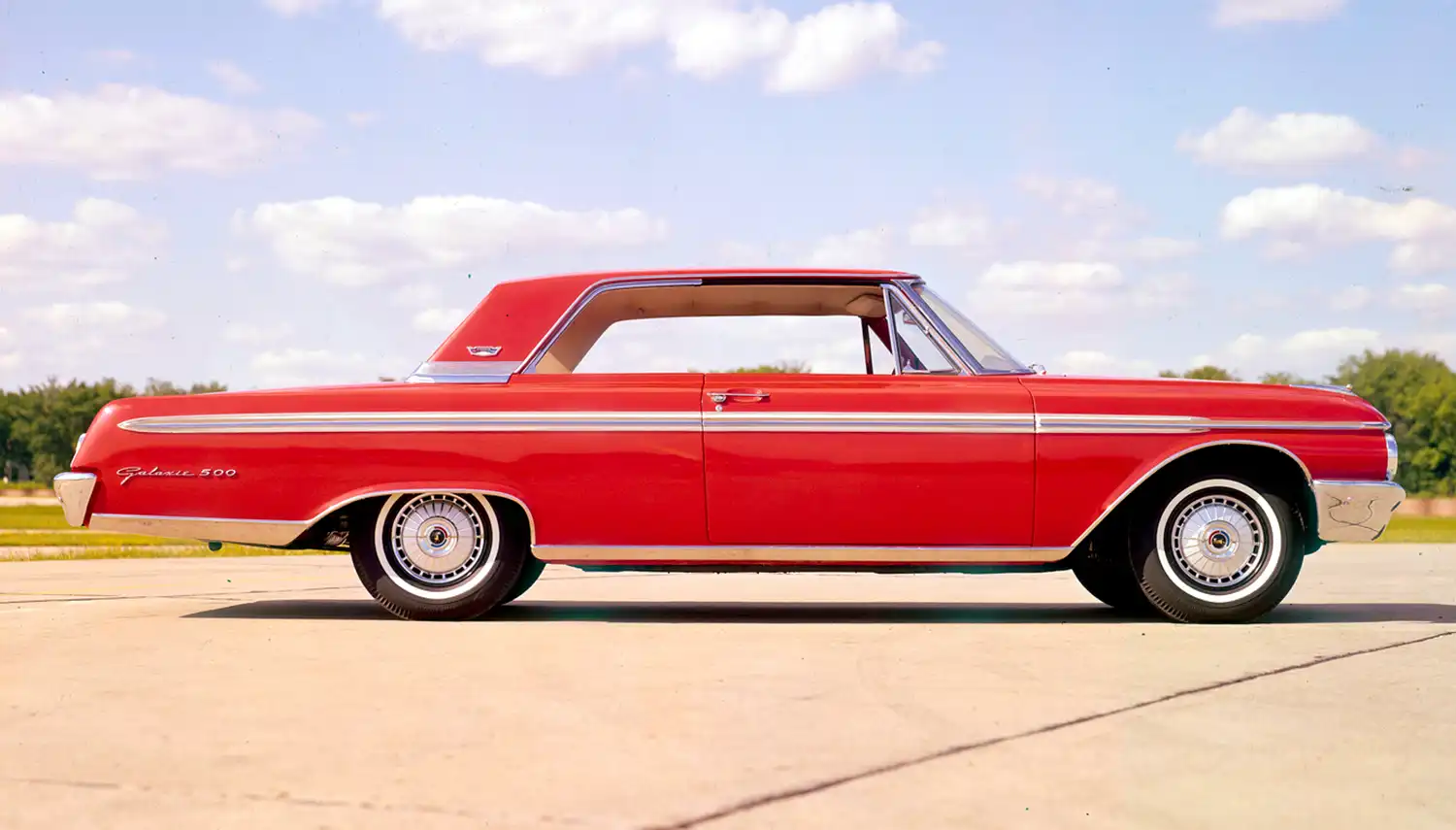
The 1962 Ford Galaxie 500 two-door hardtop stands as a significant icon of early 1960s American automotive design, representing a shift towards sleeker, more streamlined styling compared to the bolder fins of the late 1950s. The Galaxie name itself was introduced in 1959 as the top-of-the-line full-size Ford, intended to evoke the excitement of the Space Race. By 1962, the Galaxie had evolved into a distinct model line, with the 500 designation signifying the premium trim level.
The two-door hardtop body style offered a sporty yet sophisticated look, combining the elegance of a coupe with the airy feel of a pillarless design when the windows were down. This model year was particularly notable for its “swept-back” roofline on the hardtops, a design element that contributed to its dynamic and modern appearance. The Galaxie 500 aimed to appeal to a broad range of buyers seeking a stylish, comfortable, and well-equipped full-size car, capable of both comfortable cruising and respectable performance depending on the engine choice. Its presence in popular culture and its enduring design have solidified its place as an “Auto Icon” of its era.
Engine Options and Performance
The 1962 Ford Galaxie 500 two-door hardtop offered a diverse array of engine options to cater to varying performance needs and budgets. The standard engine was typically an inline-six, providing adequate power for everyday driving. However, the Galaxie 500 was most often associated with its V8 engine offerings, which ranged from smaller displacement units focused on fuel efficiency to larger, more powerful options designed for spirited performance. Popular V8 choices included the 292 cubic inch Y-block V8, as well as the newer small-block Ford V8s like the 260 and 289 cubic inch units, which offered a good balance of power and weight.
For those seeking genuine muscle car performance in a full-size package, Ford offered larger FE-series V8 engines, such as the 352 and the potent 390 cubic inch V8. The 390, with its four-barrel carburetor, could produce upwards of 300 horsepower and provided impressive acceleration for a car of its size. Transmission choices typically included a three-speed manual (with or without overdrive), a two-speed Fordomatic automatic, or the more advanced three-speed Cruise-O-Matic automatic, allowing buyers to tailor the driving experience to their preference.
Sleek Styling and Hardtop Elegance
The 1962 Ford Galaxie 500 two-door hardtop was characterized by its clean and contemporary styling. The “swept-back” roofline was a defining feature, giving the car a longer, lower, and more dynamic profile compared to previous Ford designs. The pillarless hardtop design, when the side windows were lowered, created a seamless and open feeling, enhancing the sense of style and sophistication. The front end typically featured a clean grille design with dual headlights, while the rear sported distinctive round taillights, a Ford styling cue that would become iconic. Chrome trim was used judiciously to accent the car’s lines, adding a touch of elegance without being overly ornate. The overall design aimed for a balance between sporty flair and mature refinement, appealing to a wide range of buyers in the competitive full-size car market.
Interior Comfort and Features
Inside, the 1962 Ford Galaxie 500 two-door hardtop offered a comfortable and well-appointed environment for its time. The premium 500 trim level typically included upgraded upholstery materials, often featuring durable and attractive fabrics or vinyls. Bench seats were standard, providing ample seating for up to six passengers, while optional bucket seats with a center console could be ordered for a sportier feel in the front. The dashboard layout was functional and easy to read, with a wide speedometer and gauges for essential information. Features like power steering and power brakes were popular options, enhancing the driving ease and comfort of this large car. Air conditioning was also available for those in warmer climates. The spacious interior and large trunk made the Galaxie 500 a practical choice for families and those who valued comfort on the road.
Market Position and Legacy
The 1962 Ford Galaxie 500 two-door hardtop occupied a significant position in the American automotive landscape of the early 1960s. As a premium full-size offering from one of the “Big Three” automakers, it competed directly with models like the Chevrolet Impala and the Plymouth Fury. Its combination of stylish design, comfortable features, and a wide range of engine options made it a popular choice among American car buyers. The “swept-back” hardtop styling, in particular, became a hallmark of the era. The Galaxie 500’s presence extended beyond everyday transportation, with high-performance versions achieving success in NASCAR and further cementing the car’s image as both stylish and capable. Today, the 1962 Ford Galaxie 500 two-door hardtop is a sought-after classic, appreciated for its iconic mid-century design and its representation of a pivotal era in American automotive history. Its enduring appeal makes it a true “Auto Icon.”
Summary:
- The 1962 Ford Galaxie 500 two-door hardtop featured a sleek “swept-back” roofline and pillarless design.
- It offered a range of engine options, including inline-six and various V8s up to the powerful 390.
- Transmission choices included manual and automatic options.
- The interior provided comfortable seating and available features like power steering and air conditioning.
- It was a popular premium full-size car competing with Chevrolet and Plymouth.
- High-performance versions had success in NASCAR, enhancing its image.
Disclaimer: Information provided is for general informational purposes only and is based on available details. Specific specifications and features may have varied based on production variations and optional equipment.
Source: Ford Heritage Vault
AI Assistance: Gemini
